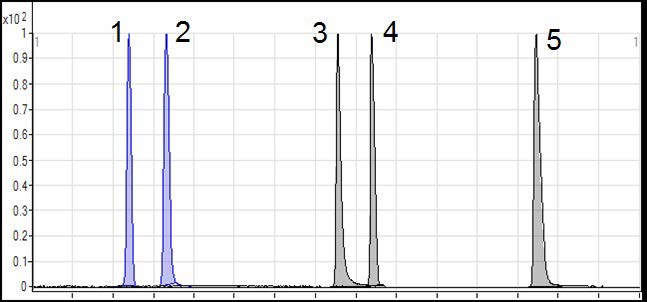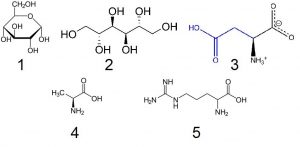Glucose, Mannitol, Aspartic Acid, Alanine and Arginine
Metabolomics analysis encompasses a vast array of molecules with disparate hydrophobic/hydrophilic properties. Many of these analytes are in fact quite polar and problematic to retain by conventional Reversed Phase Chromatography.
The Cogent Diamond Hydride Column is quite well-suited to their separation. This application demonstrates this property through the separation of five notable polar compounds that may be of interest to metabolomics separations.


Peaks:
1. Glucose
2. Mannitol
3. Aspartic Acid
4. Alanine
5. Arginine
Method Conditions
Column: Cogent Diamond Hydride™, 4μm, 100Å
Catalog No.: 70000-15P-2
Dimensions: 2.1 x 50 mm
Mobile Phase:
—A: 50% DI Water/ 50% Acetonitrile/ 0.1% Formic Acid/ 100µM Sodium Acetate
—B: Acetonitrile/ 0.1% Formic Acid
Gradient:
| Time (Minutes) | %B |
| 0 | 90 |
| 1 | 90 |
| 3 | 80 |
| 4 | 80 |
| 5 | 50 |
| 6 | 50 |
| 7 | 25 |
| 10 | 25 |
| 11 | 90 |
Post Time: 5 minutes
Injection vol.: 1μL
Flow rate: 0.6 mL/minute
Detection: ESI – POS – Agilent 6210 MSD TOF Mass Spectrometer
Notes: Sugar Alcohols differ from Sugars in that the Carbonyl group of the former has been reduced to an Alcohol group. They don’t raise blood sugar levels to the same extent that regular Sugars do and hence are often used in diabetic foods when a sweet taste is still desired. Amino Acids have many biological functions and are the building blocks of Peptides and Proteins.
Attachment
No 366 Sugars Sugar Alcohols and Amino Acids AppNote 0.2 Mb Download File


